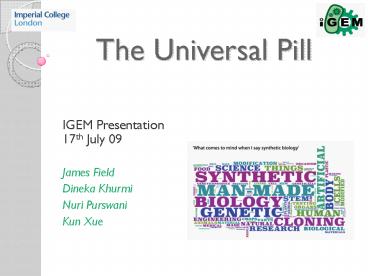The Universal Pill - PowerPoint PPT Presentation
Title:
The Universal Pill
Description:
Symbiotic Microbe. Secretion. Sustained drug production. Multiple ... Combining polysaccharide & symbiotic microbe delivery offers the following advantages: ... – PowerPoint PPT presentation
Number of Views:70
Avg rating:3.0/5.0
Title: The Universal Pill
1
The Universal Pill
- IGEM Presentation 17th July 09
- James Field
- Dineka Khurmi
- Nuri Purswani
- Kun Xue
2
Project Description
- Problem for oral delivery of peptides
- 1 pill 1 drug
- High manufacturing cost
- Variable peptide half life
- Solution
- User defined drug production
Specification
Design
Modelling
Implementation
Testing/Validation
3
The Universal Pill
- Multiple inputs enable drug selection
- Offers uniformity
- Direct packaging
- Fresh peptide production
- Dosage control
- Reduced loss of peptide
Capsule
Bacteria
Specification
Design
Modelling
Implementation
Testing/Validation
4
Current Methods
Specification
Design
Modelling
Implementation
Testing/Validation
5
Integrated Solution
Specification
Design
Modelling
Implementation
Testing/Validation
6
Chosen Solution
- Polysaccharide encapsulation
- of chassis
- Combining polysaccharide symbiotic microbe
delivery offers the following advantages - Synthesis on demand without risk of GMO
- Protein is not denatured during storage
transport
Specification
Design
Modelling
Implementation
Testing/Validation
7
Mechanism Overview
- Polysaccharide encapsulation of chassis.
- Peptide synthesis prior to consumption.
Encapsulate
Express
Kill
Release
Specification
Design
Modelling
Implementation
Testing/Validation
8
Light Trigger Logic Circuit
0
Drug 1
R 0 B 0
No production
B
R 0 B 1
Drug 1
R
Drug 2
0
R 1 B 0
Drug 2
R 1 B 1
Drug 3
Drug 3
Specification
Design
Modelling
Implementation
Testing/Validation
9
Proposed Applications
10
Chassis Criteria
- Non pathogenic strain
- Large Biobrick availability
- Expertise in college
- Freeze dry
Testing/Validation
11
Chassis considerations
12
Capsule Design Overview
- Encapsulation
- Storage
- Protein expression
- 4) Acid resistance
- 5) Release
13
1) Encapsulation
- enhances cell resistance to freezing and
freeze-drying (for storage) - added convenience and reduced packaging costs
- longer stability and viability during storage
14
Encapsulation Method Comparison
15
Encapsulation details
An in situ method for cultivating microorganisms
using a double encapsulation technique Eitan
Ben-Dov1,2, Esti Kramarsky-Winter3,4 Ariel
Kushmaro1,5
16
2) Storage
- Short term storage-up to a month
- Nutrient agar
- Keep in a sealable container
- Storage in refrigerator
- Long term storage
- Inclusion of glycerol
- storage in freeze-dried form
- freeze at -20C or -80C
17
Freeze drying
18
3) Protein expression
- Transparency to light important for light inputs
reaching cells - Alginate is transparent
- Transparency type nutrient agar
19
Protein Deposition
- Proteins expressed are exported from the cell
into the nutrient agar - Proteins stored in pores of nutrient agar until
release
20
4) Resistance to stomach acidity
- Exposure of bifidobacteria to simulated gastric
juice at pH 2.0 - Diameters of 4080 µm
- - insignificant protection
- 13 mm
- - microspheres protected entrapped cells
Encapsulation in alginate-coated gelatin
microspheres improves survival of the probiotic
Bifidobacterium adolescentis 15703T during
exposure to simulated gastro-intestinal
conditions N.T. Annana, A.D. Borzaa and L.
Truelstrup Hansen
21
Resistance to Acidity
- When pH is lowered below the pKa values of
d-mannuronic and l-guluronic acid (3.6 and 3.7,
respectively), alginate is converted to alginic
acid with release of calcium ions - Stomach pH is at 1-3
- Disintegration times for alginate-coating was 120
min
22
5) Release
- Full degradation of alginate coat in intestines
- Protein in nutrient agar now released
23
The Vision
LOAD PILL
SELECT DRUG
SELECT DOSE
COMPETE
24
Black Box
Light
Chemical
25
BLACK BOX Modules
Drug Control
Dose Control
Light Sensing
Frequency
Timer
Wavelength
Peptide synthesis
Restriction enzyme synthesis
26
INPUT Encoding with Light
Wavelength
Pulse
Cph8
1
0
YcgF/YcgE
Time
Drug Choice
Dosage
27
Wavelength Encoding
Input
A
B
C
Output
1, 0
1, 1
0, 1
28
Genetic Simulation
COMMAND ACTIVATE A
A
A
P1 G1 G2
B
P2 G3 G4
C
P3 G5 P4 G6
29
Genetic Simulation
COMMAND ACTIVATE B
A
B
P1 G1 G2
B
P2 G3 G4
C
P3 G5 P4 G6
30
Genetic Simulation
COMMAND ACTIVATE C
A
C
P1 G1 G2
B
P2 G3 G4
C
P3 G5 P4 G6
31
Pulse Encoding
Input
Output
32
Excitable protein output
Protein
Time
Specification
Design
Modelling
Implementation
Testing/Validation
33
Comparator Specifications
- 1 Strong Biobrick characterisation.
- 2 Precise relationship between coexpressed drug
and reporter group. - 3 Defined time in which to compute required
pulse frequency.
34
Timer Specifications
- 1 Responsive to 1st light pulse only.
- 2 Restriction enzymes expressed at end of time
period.
35
Operation Summary
Select desired drug
INPUT MODULATION
Select desired dosage
COMPARATOR MODULATION
Light
Chemical
36
Summary
Light Receptor
Start Timer
Threshold detector
Wavelength Processing
Pulse Processing
Restriction Enzyme Synthesis
Drug Synthesis Secretion
37
Modelling considerations Components
- Protein controlled timer
- Simple logic gate representations
- Timer block
- Rate of protein expression and degradation (ETH
07) - Threshold mechanism Schmitt trigger (Taipei
07) - Encapsulation efficiency
- Particle size, morphology, swelling (Martins et
al 2007) - Metabolic considerations
- Behaviour of bacteria inside the capsule (Wen-tao
Qi et al. 2005) - Comparison with free in culture medium
38
Model parameters
- Protein controlled timer
- - Light absorbance, pigment formation Directly
indicative of amount of protein present? - Encapsulation efficiency
- - Diffusion of drug through capsule
- Metabolic considerations
- - Bacterial growth rate, population consumption
39
Questions we would expect our models to answer
- Protein controlled timer
- - Obtain optimal input light conditions for
protein degradation. - Encapsulation efficiency
- - Find out optimal dimensions for maximal
diffusion of substances through capsule. - Metabolic considerations
- - Find optimal nutrient agar composition to
obtain indication of bacterial survival.
40
Summary
- Solution
- User defined drug production for oral
administration - 1 pill 1 drug
- High manufacturing cost
- Variable peptide half life































